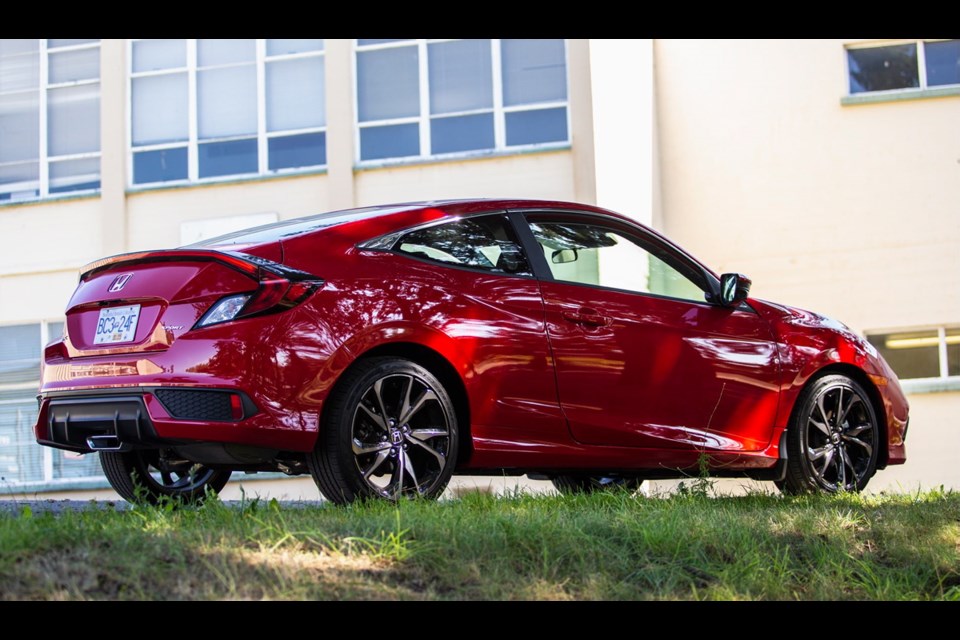When Canadians look to buy a new car in 2019, more often than not they will pick a Honda Civic, the country’s best-selling passenger car for 21 consecutive years.
In a time when SUVs seem to be all everybody wants to talk about and the car market is in a steady decline, the Civic keeps getting stronger, easily outselling its competitors, such as the Toyota Corolla and the Hyundai Elantra.
Other manufacturers, such as Ford and Fiat Chrysler Automobiles, have given up the fight entirely, discontinuing small four-door sedans and hatchbacks from their lineups.
What is it about the car that makes it so popular?
I recently got an opportunity to spend a week behind the wheel of a 2019 Honda Civic Coupe.
When the first subcompact Civic rolled into dealerships in 1972, buyers could get one with a trunk or hatchback.
It has grown, in more ways than one, in the ensuing years. It is now in its 10th generation, which debuted as a 2016 model.
There is no two-door hatchback any more. The lineup now includes a coupe, a sedan and a four-door hatchback. Honda satisfies the need for speed in some consumers with the Coupe Si, Sedan Si and the high-performance Type R.
If those aren’t enough to choose from, the Coupe can be ordered in three trim levels — LX, Sport and Touring. In the lower two trims, one can order a manual or automatic transmission. The Touring only comes with the automatic (the Si is only available with a manual).
My tester was equipped with the automatic — unfortunately.
When you lay eyes on the Civic Coupe, your pulse quickens. There are several reasons why you might be excited. You might be single, have gotten a good-paying job and the Civic will be your first fun (but reliable) car.
Or you might be of a certain age, with your parenting days finally over. The back seats aren’t as important as the freedom to have fun once again.
While there are other two-door coupes in the market, most are sports cars, more powerful — and more expensive. The Civic Coupe stands alone as the only one offering fun and performance on a modest budget.
Once you have decided on the Civic Coupe, the first question is how much fun you want. The LX and Sport give you a naturally aspirated 2.0-litre four-cylinder engine producing 158 horsepower and 138 pound-feet of torque. The Touring ups the ante, with a turbocharged 1.5-litre four boasting 174 hp and 162 lb.-ft. of torque.
The 2.0-litre doesn’t set the world on fire compared with others in the field, but it doesn’t embarrass, either. Power is more than adequate for merging on the highway and overtaking when needed.
What the Civic lacks in zero-to-100 km/h times, it makes up in fuel efficiency. Even equipped with an automatic, my Sport still boasted a fuel consumption rate of 8.3 litres/ 100 km in the city and 6.6 on the highway.
The Achilles heel, in my opinion, is the continuously variable transmission. I have driven numerous Civics, and they have all been fun to drive. Some have also been equipped with regular automatics with gears. Honda’s CVT, with its belt and pulley system, just isn’t as responsive when acceleration at low speeds is called for.
(Toyota has addressed this problem with introducing a launch gear, acting like first gear, to power the new Corolla from a standing start. Once the vehicle has built up speed, it then reverts back to the CVT.)
Otherwise, the Civic is a very engaging car to drive, with a suspension and ride that soak up the bumps and inspire driver confidence.
Although it is equipped with humble McPherson struts, you won’t care as you will take those back-road twisties with ease (and flair, maybe).
The Civic cabin is surely the benchmark for the segment. The whole interior is covered in quality materials, and the ergonomics of all the disparate elements is spot on.
The front seats were comfortable and supportive, although some with an ample girth may find the side bolsters intrusive.
The coupe body means that rear headroom is compromised. I had a six-foot, two-inch passenger for a short trip, and he had to slouch the entire time.
For 2019, Honda’s infotainment system has finally returned to a rotary knob for the radio (its previous slider was terrible).
A driver safety suite includes a collision-mitigation braking system, forward collision warning and Honda’s LaneWatch (a camera located on the outside mirror that comes on when you indicate you are changing lanes).
If I was choosing for myself, I would most likely chose the Civic Si, with 205 hp and 192 lb.-ft. of torque as my ride.
But if you are just looking for a reliable, good-looking and fun ride that won’t break your bank, the Civic Coupe Sport is as good as it gets.
THE SPEC SHEET
Type: Compact two-door coupe, front engine, front-wheel-drive
Engine: 2.0-litre four-cylinder, 158 hp at 6,500 r.p.m., 138 lb.-ft. of torque at 4,200 r.p.m.
Transmission: Continuously variable
Dimensions (mm): Length, 4,503; width, 1,878; height, 1,395; wheelbase, 2,700
Curb weight (kg): 1,299
Price (base/as tested): $27,270/ $29,150 (includes $1,780 freight and PDI and $100 AC tax)
Options: CVT included in price
Tires: 235/40 R18 on alloy wheels
Fuel type: Regular
Fuel economy (L/100km): 8.3 city/ 6.6 highway
Warranty: Three years/60,000 km new car, five years/100,000 km powertrain, three years/ unlimited km roadside assistance



